New report: ‘Achieving EU’s climate goals through circular construction’
February 27, 2023
The European Circular Economy Stakeholder Platform (ECESP) Leadership Group on Buildings and Infrastructure has launched a new report, ‘Achieving EU’s climate goals through circular construction’. This report analyses the role of circular construction in mitigating climate change within the European Union. The 4-pager provides key insights into the environmental impact of the construction industry, circular technologies and best practices, updates on policies, and upcoming regulations related to the built environment in the EU.
Find the main highlights below!

Impact of the Construction sector in the EU
The construction sector in the EU has a significant environmental impact, accounting for half of extracted materials and energy demand, as well as a third of water consumption, waste, and CO2 emissions. About 90% of existing buildings in the EU will still be in use in 2050, however, 75% of them are currently energy-inefficient.
Circular approaches such as designing buildings to act as carbon sinks, using renewable energy and upcycled materials, and adopting circular waste management practices can mitigate climate change and make the built environment more resilient.

Main Highlights for Achieving EU's Climate Goals through Circular Construction
Achieving the EU’s 2050 carbon neutrality goals will require a sustainable transition towards a circular built environment, where resources are efficiently used and emissions are reduced across the entire lifecycle of buildings. Main highlights for achieving climate goals are:
- Circular construction solutions, such as design for durability, use of renewable materials, and circular business models, are being implemented across the EU, offering economic benefits as well as environmental advantages.
- Integrated EU regulations to mandate materials reuse, increase public procurement, and support green construction standards will help accelerate the transition towards circularity in the construction sector.
- Through a Circular Economy the construction sector can not only become more resilient and durable to the exposure of Climate Change effects but also can be an active contributor to both adaptation and mitigation efforts.
Best practices
The report showcases exemplary case studies from each value chain segment, including building passports, circular buildings, platforms, public procurement, secondary raw materials, and standards, to demonstrate the emergence of circular construction solutions across the EU. The case studies include notable Dutch practices such as Madaster (Building passports) and the first Dutch Circular Viaduct:
- Madaster, a Dutch-origin platform operating in five EU countries, offers a web-based, standardized system to generate and register construction materials and products, with detailed inventories and environmental impact information, allowing for high-value reuse through the use of building passports.
- The first Dutch Circular Viaduct, which was designed with a modular approach and can be regularly reused and readapted, showcases the potential for circularity in infrastructure and has spurred innovations in public procurement through partnerships and knowledge sharing.
A good start to accelerate the circular transitions is the Annual Circular Economy Stakeholder Conference on the 27th and 28th of February 2023 with pioneering entrepreneurs and senior policy experts who are driving the circular transition in the built environment. Watch Holland Circular Hotspot’s session about ‘Achieving EU’s climate & biodiversity goals through circular construction’.

